How To Make Lefse: A Norwegian Potato Flatbread
This traditional Norwegian staple is easy to make and delicious to eat, served a variety of ways. Get the recipe here—no special equipment needed!
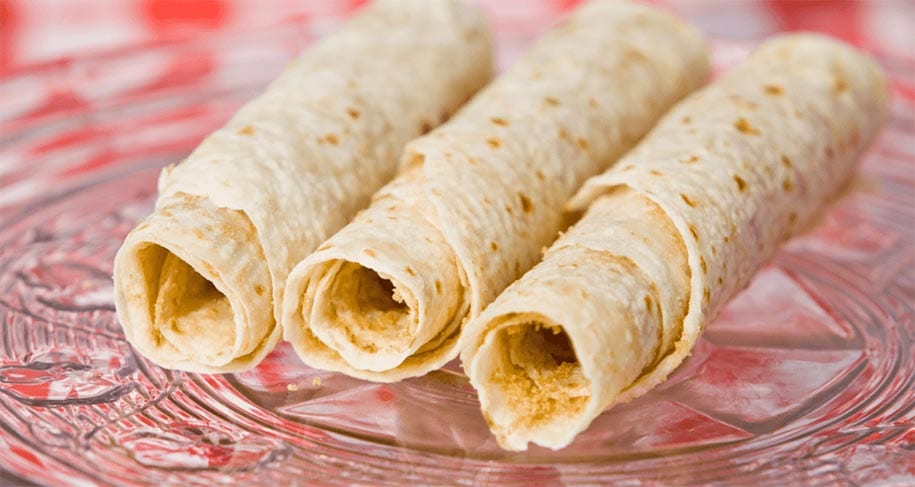
What do you get when you combine potatoes and a few common baking ingredients? A delicious morsel of Norwegian history called lefse! Lefse (pronounced “LEFF-sa”) are a lot like tortillas or flatbread, but much larger and thinner. While in years past, lefse was something of a staple food, these days it’s often served at the holidays and as an accompaniment to lutefisk (a soaked dried cod dish). But more and more people are discovering this tasty flatbread to be enjoyed any time of year.
The History of Lefse
Many stories say that lefse originated during the Viking era. However, the lefse that we know today didn’t come to be until much later. The Vikings had their own version of lefse (called Hardanger lefse) that was made with flour, not potatoes. Hardanger lefse was cooked in enormous batches then left out to dry so that it resembled a large cracker. This way, it kept for up to a year, but to eat it, you had to soak your lefse in damp cloth first.
Modern lefse came about long after the Viking age ended. Most historians agree that potatoes first arrived in Norway sometime in the 1750s, likely brought back home by traveling priests and soldiers. Shortly thereafter, potato lefse – and many other Norwegian potato dishes – started appearing.
Making Lefse At Home
Today, many people make lefse with a few common household tools – a potato ricer, a large frying pan or griddle, and a rolling pin. However, there are a few specialty tools that make the process much easier.
The first thing you’ll notice about traditional lefse is that it has a corrugated or striped texture. This is because traditional Norwegian cooks use ribbed, cloth-covered rolling pins so that they don’t have to use as much flour to keep the dough from sticking to the rolling pin. Instead of using a floured board to roll out the dough, many traditional cooks also use a canvas pastry cloth.
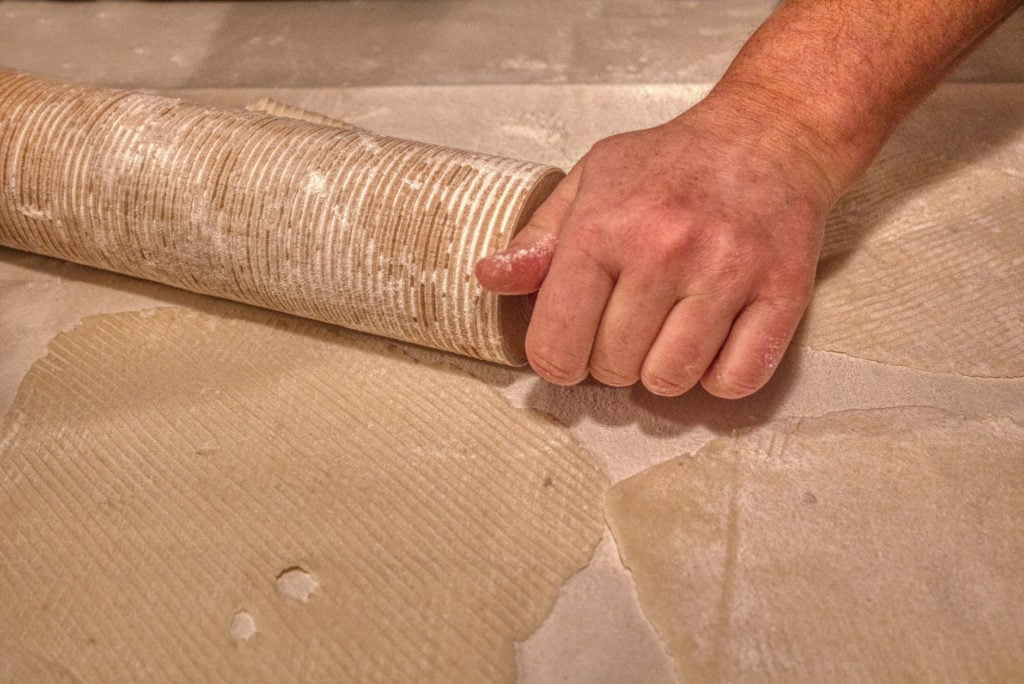
To cook the lefse, most traditional cooks use a lefse grill, which is a large, thin and flat grill that gets hotter than a frying pan. Finally, you’ll need a lefse stick. This long, thin wooden tool looks like a cross between a large spatula and a tiny boat oar. Its shape and size make it much easier to turn the lefse as you cook it.
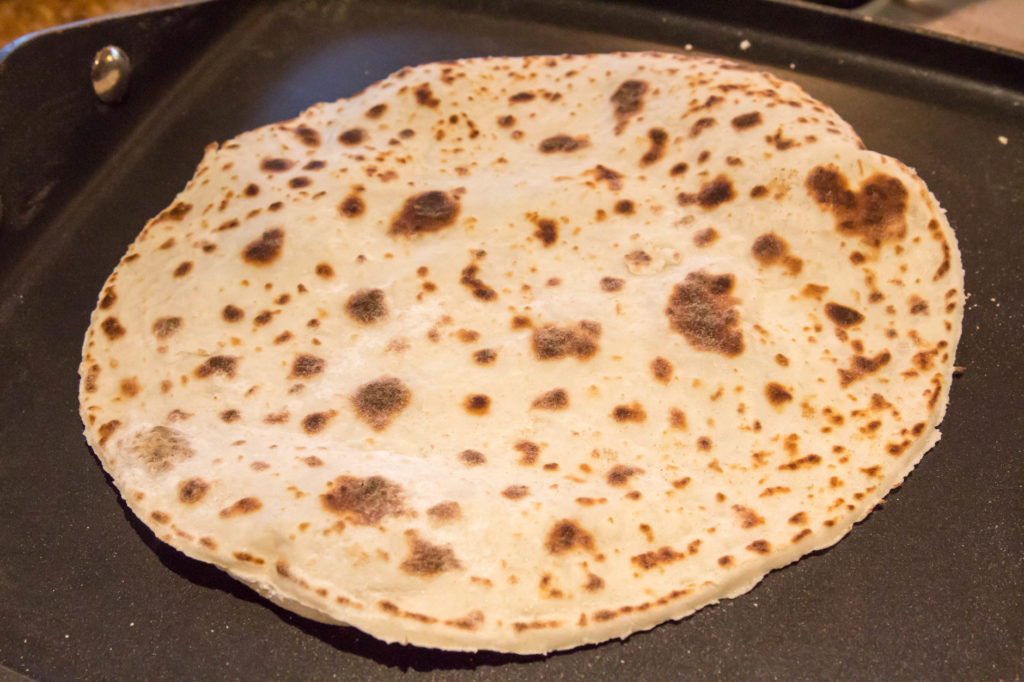
Watch lefse preparation and cooking techniques in this video:
Traditional Norwegian Lefse Recipe
Ingredients:
- 5 pounds Russet or other starchy potatoes (should make approximately 4 cups of potato rice)
- 1/4 cup unsalted butter, room temperature
- 1/4 cup heavy cream
- 2 tsp salt
- 1 Tbsp sugar
- 1 cup flour (you may need a little more or less depending on the consistency of your dough)
Instructions:
- Start by cutting the potatoes into chunks and then cooking them in a small saucepan until they’re fork-tender. Then, use a potato ricer to rice the potatoes into a large bowl.
- After you’ve riced the potatoes once, give the potatoes a second pass through the ricer. Then add the butter while the potatoes are still warm.
- Add the cream, sugar, and salt, and mix well. The mixture can keep in the refrigerator for a few days if you don’t want to make lefse right away.
- When you’re ready to make lefse, add the flour to the potato mixture and mix it until dough starts to form. This might take a while – lefse dough usually starts out crumbly. Once the mixture starts coming together, you’re ready to roll the dough into balls.
- Clear a large workspace for your lefse cloth and have some flour handy. Take about 2 tablespoons of dough and roll it into a ball between your palms. Then flatten the ball onto a well-floured board, using a well-floured rolling pin.
- To cook the lefse, use a non-stick lefse grill or a large cast iron skillet over medium-high heat. Heat the pan until it’s warm enough that water droplets will sizzle. Then place a lefse on the pan and let it cook until both sides have nicely browned spots (like a tortilla). You shouldn’t need to use oil.
Keep the lefse warm in a cloth until ready to serve. Makes 36 pieces of lefse.
How To Eat Lefse
Use lefse as you would flatbread or tortillas to make your favorite foods taste that much better! Get creative, but here are some ideas, courtesy of the Lefse Ladies!
- Spread with butter and sprinkle with brown sugar. This is a traditional way to eat lefse.
- Spread with mustard and wrap around Polish sausage, brats, or hot dogs.
- Spread with butter or cream cheese and wrap around leftover chicken, turkey, pot roast, or your favorite deli meat. Eat hot or cold.
- Use as a wrap for salads such as egg, tuna, chicken and salmon.
- Fill with your favorite canned fruit, warm in a microwave and serve with whipped cream.
- Spread with your favorite jelly, jam or preserves.
- Make “Uff Da” chips by cutting into 1” x 4” strips and deep fry until golden. Drain on a paper towel and immediately sprinkle with cinnamon and sugar. Or spread whole round with butter, sprinkle with cinnamon and sugar, cut into 1”x4” strips, put on a cookie sheet and bake at 300 degrees until crisp.
- Use with fish tacos instead of corn tortillas.
- Spread with cranberry sauce.
- Spread with Nutella.
- Wrap around warm meatballs.
- Spread with applesauce.
- Wrap around scrambled eggs, with or without crumbled sausage or bacon.

Amber Kanuckel
Amber Kanuckel is a freelance writer from rural Ohio who loves all things outdoors. She specializes in home, garden, environmental, and green living topics.


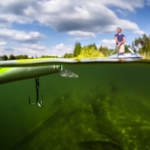

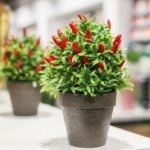

I’ve grown up with all the various scadanavian foods. It was normal in Minnesota to have your freezer full of goodies for your quests. Now living in Colorado my parents brought all the Norwegian gifts here and I now incorporate them with my husbands German goodies. We both bake and our holidays are full of such wonderful heritages. Thank you for sharing.
Sorry, Donald Moffat, but Decorah, Iowa is the home of Luther College, not Concordia.
My grandmother on my father’s side was from Norway. We made lefsa at Thanksgiving and Christmas. I still do, it just would be the holidays with out it. My sons and my father fight over who is going to eat the most. We eat it still warm with just butter on it. Every time I make it I think of her and all the wonderful memories.
For a person from Western Norway this is a recipe for potato cakes, and they have nothing to do with traditional lefse that have been made for ever so long.The lefse could be stored for a long time.The potato came to Norway in the begining of the 1800s.The potato cakes will mold pretty quickly.
I have been eating lefse as long as I can remember. Last year, for a new twist, I made homemade honey butter (honey, cream, powdered sugar) and put on the lefse and rolled. Everyone just LOVED it! Give it a try 🙂
When I was child and mom made lefse she fried it on top of a cast iron stove It was much better that way because it got hotter.Now I have a griddle.Some kept their stoves just to make lefse.We make 10lbs of potatoes for the holidays my girls help.
I make and prefer the hardanger lefsa. The other lefsa was called potato cakes at home and my sister makes this. My Norwegian family comes from the Hjelmeland Rogaland area.
My grandma on my dads side would make this and my aunt would make this also every Christmas! As kids we would help. After my grandma passed away I got all her Lefse making items! I was super excited! I’m not blood I was adopted when I was two and I’m full Korean and my husband is Guatemalan and Mexican so he has never had it. I made it for the first time by myself in 6th grade for my Econ class for a project and came out great my mom and sister couldn’t stop eating it! I now make it every Christmas and I make about 7 pounds for moms side and dads side of the family! This recipe is a little different then what I grow up with! We only use white or yellow potatoes and no salt and sugar inside the mixture but we use a stick of real butter. I love the fact that my father side is real full Norwegian !!!!
We still eat it every Xmas and have as long as I can remember. 57 now. My Grandmothers, I always thought hers was the best, but my sister, who used to make it with her and now that grandma has been gone now a few years, I can honestly say is fantastic. Butter and white sugar is our family tradition, in most cases, but there are a few that like brown sugar instead.
My Grandma used to make this but she used lard instead of butter. It was fantastic!!! Had it when I was a child. I am thinking about making it myself. Yummmm